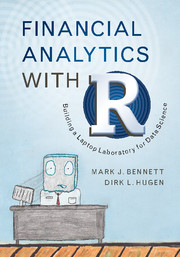Book contents
- Frontmatter
- Dedication
- Contents
- Preface
- Acknowledgments
- 1 Analytical Thinking
- 2 The R Language for Statistical Computing
- 3 Financial Statistics
- 4 Financial Securities
- 5 Dataset Analytics and Risk Measurement
- 6 Time Series Analysis
- 7 The Sharpe Ratio
- 8 Markowitz Mean-Variance Optimization
- 9 Cluster Analysis
- 10 Gauging the Market Sentiment
- 11 Simulating Trading Strategies
- 12 Data Exploration Using Fundamentals
- 13 Prediction Using Fundamentals
- 14 Binomial Model for Options
- 15 Black–Scholes Model and Option-Implied Volatility
- Appendix Probability Distributions and Statistical Analysis
- References
- Index
15 - Black–Scholes Model and Option-Implied Volatility
Published online by Cambridge University Press: 20 October 2016
- Frontmatter
- Dedication
- Contents
- Preface
- Acknowledgments
- 1 Analytical Thinking
- 2 The R Language for Statistical Computing
- 3 Financial Statistics
- 4 Financial Securities
- 5 Dataset Analytics and Risk Measurement
- 6 Time Series Analysis
- 7 The Sharpe Ratio
- 8 Markowitz Mean-Variance Optimization
- 9 Cluster Analysis
- 10 Gauging the Market Sentiment
- 11 Simulating Trading Strategies
- 12 Data Exploration Using Fundamentals
- 13 Prediction Using Fundamentals
- 14 Binomial Model for Options
- 15 Black–Scholes Model and Option-Implied Volatility
- Appendix Probability Distributions and Statistical Analysis
- References
- Index
Summary
When traveling across the agricultural American Midwest, one can hear AM radio stations broadcast the futures prices of corn, soybeans, wheat, and other commodities every weekday at various times of the day. Iowa and Illinois lead the nation in corn production. Kansas leads the nation in wheat production. Listening to these farm reports is entertaining. Included in the broadcasts are very detailed weather reports. Weather is critical to many producers’ livelihoods. After a few weeks of listening to these broadcasts, we learn that nobody truly knows for sure whether the agricultural market prices will go up or down on a trading day. Hedging the production chain price risk, especially for the farmers, who seasonally grow the crops, is achieved with futures and option securities. Producers very often want to lock in a price for delivering corn at the end of the season, or want to be compensated for a significant reduction in the agricultural price in order to guarantee recovering their fixed costs over the upcoming days and months.
From Chapter 14, we have gained more familiarity with the random walk processes assumed by the option models. We continue the option theme from the prior chapter and examine a very popular model for pricing European options. The most famous and widely accepted model of option valuation model is known as the Black–Scholes model of 1973 (Black and Myron, 1973). It revolutionized the pricing and trading of options which, prior to this, were priced in rather arbitrary ways. Black and Scholes relied upon the stochastic calculus. Stochastic calculus was invented by Itô in 1951 to address the need for a calculus for random variables as functions over time, like our stock market prices (Ito, 1951). Together with Merton, Black and Scholes were awarded the 1997 Nobel Prize in Economic Sciences for this invention. We discuss the Black–Scholes model here in order to complete our tour of financial analytics. We will try to make minimal use of stochastic calculus.
We saved this more mathematical material for the end of the book because it involves the more complex type of security: options. As mentioned in Chapter 14, options are derivative securities.
- Type
- Chapter
- Information
- Financial Analytics with RBuilding a Laptop Laboratory for Data Science, pp. 331 - 349Publisher: Cambridge University PressPrint publication year: 2016



